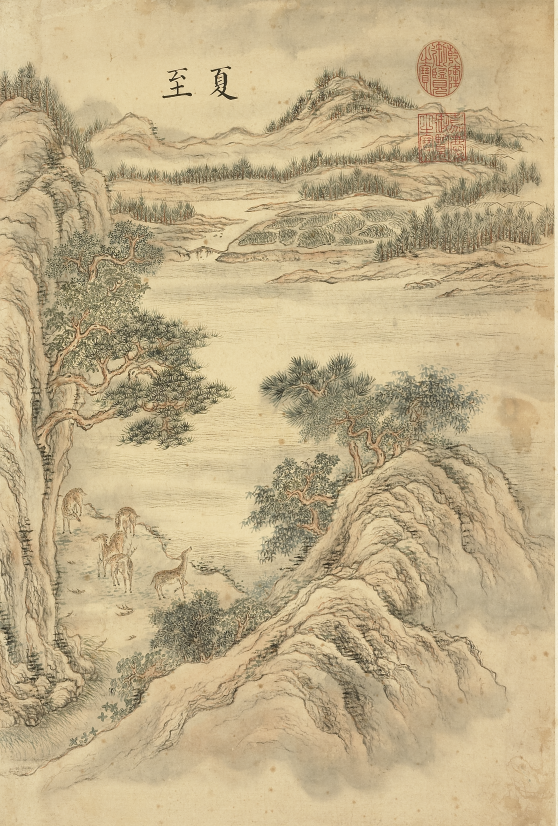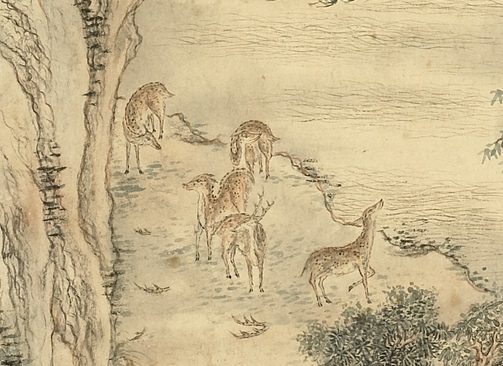A note on antler-shedding
- Rachelle
- Dec 11, 2023
- 3 min read
麋角解者,說者多家,皆無眀據。熊氏云鹿是山獸,夏至得隂氣而解角。麋是澤獸,故冬至得陽氣而解角。今以麋為隂獸,情淫而逰澤,冬至隂方退,故解角從陰退之象。鹿是陽獸,情淫而逰山,夏至得隂而解角,從陽退之象。既無眀據,故畧論焉。若節氣早則麋角十一月解,故《夏小正》云“十一月麋角隕墜”是也。若節氣晚則十二月麋角解,故《小正》云“十二月隕麋角。”
There are many theories about “the mi-deer [1] shedding antlers”, but none of them offers clear evidence. According to Mr. Xiong, [2] the lu-deer [3] is a beast of the mountains and sheds its antlers on receipt of the yin force of the Summer Solstice; the mi-deer is a beast of the marshes and sheds its antlers on receipt of the yang force of the Winter Solstice. Now the mi-deer is considered a beast of yin which, indulging in its nature, roams about on the marshes. The yin force does not begin to recede until the Winter Solstice, so [the mi-deer’s] antler-shedding is a sign of the ebbing of yin. The lu-deer is a beast of yang which, indulging in its nature, roams about in the mountains. It sheds its antlers on receipt of the yin force of the Summer Solstice, as a sign of the ebbing of yang. Due to the absence of clear evidence, Mr. Xiong’s arguments are brief. When the solar terms come earlier than usual, the mi-deer sheds its antlers in the eleventh month; that is why the “Xia xiaozheng” chapter [4] says “the mi-deer’s antlers fall off in the eleventh month”. When the solar terms come later than usual, the mi-deer sheds its antlers in the twelfth month; that is why the “[Xia] xiaozheng” chapter [also] says “the mi-deer’s antlers fall off in the twelfth month”.
*From the canonical commentary edited by Kong Yinda 孔穎達 (574-648) on the Liji 禮記: https://ctext.org/library.pl?if=en&file=75075&page=55.
[1] Mi 麋 refers to the Père David’s deer, or elaphure (Elaphurus davidianus), a species of deer native to China. Another common name for it is milu 麋鹿 (literally “elaphure-deer”), which is a compound consisting of two characters that can each refer to a specific kind of deer. The passage here deals exactly with the distinction between the two elements in this compound, so my translation keeps pinyin for the monosyllabic terms in the original to avoid confusion.
[2] Referring to Xiong Ansheng 熊安生 (fl. 6th century), a scholar in the study of rites whose works are mostly preserved as fragments quoted in later commentaries.
[3] Lu 鹿 can be used as a generic term for cervine animals, but the context stipulates that it is to be understood in a narrower sense here: sika deer (Cervus nippon), a species of deer native to much of East Asia.
[4] “Xia xiaozheng” is a chapter of the Da Dai Liji 大戴禮記 by Dai De 戴德 (fl. 43-44 BCE), one of the most indispensable works on the study of ancient rites.
Album leaf on the Summer Solstice by Zhang Ruoai 張若靄 (1713-1746)
Image credit: National Palace Museum, Taipei

Antlers shed by roe deer
Copyright Declaration*:
The texts and images used on the website of Rachelle's Lab are either from the public domain (e.g. Wikipedia), databases with open data licenses (e.g. Shuhua diancang ziliao jiansuo xitong 書畫典藏資料檢索系統, National Palace Museum, Taipei), online libraries that permit reasonable use (e.g. ctext.org), or original work created for this website.
Although fair use of the website for private non-profit purposes is permitted, please note that the website of Rachelle's Lab and its content (including but not limited to translations, blog posts, images, videos, etc.) are protected under international copyright law. If you want to republish, distribute, or make derivative work based on the website content, please contact me, the copyright owner, to get written permission first and make sure to link to the corresponding page when you use it.
版權聲明:
本站所使用的圖片,皆出自公有領域(如維基)、開放數據庫(如臺北故宮博物院書畫典藏資料檢索系統)、允許合理引用的在線圖書館(如中國哲學電子化計劃)及本人創作。本站允許對網站內容進行個人的、非營利性質的合理使用。但請注意,本站及其內容(包括但不限於翻譯、博文、圖像、視頻等)受國際版權法保護。如需基於博客內容進行出版、傳播、製作衍生作品等,請務必先徵求作者(本人)書面許可,并在使用時附上本站鏈接,註明出處。
*Read more about copyright and permission here.





Comments